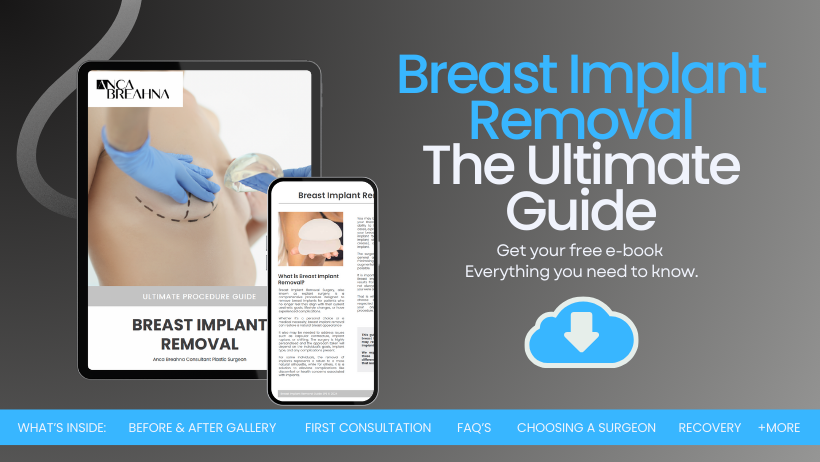
Returning to Exercise after Breast Implant Removal Surgery
Breast implant removal surgery, also known as explant surgery, is a decision that many women make for various reasons, including health concerns, personal preferences, or changes in aesthetic desires. One of the most common questions that arise post-surgery is regarding the return to exercise. Engaging in physical activity after surgery is not just a matter of personal health and wellness; it’s also crucial for the recovery process. But it’s essential to approach this transition with care to ensure a safe and effective recovery.
In this blog, Chester Consultant Plastic Surgeon Anca Breahna will explore the journey back to exercise after breast implant removal surgery, offering insights and advice to navigate this phase with confidence.
Download Anca Breahna’s Breast Implant Removal Guide

Understanding the Recovery Timeline
The first step towards a safe return to exercise is understanding the recovery timeline post-explant surgery. The body needs time to heal, and this period can vary depending on individual factors such as the complexity of the surgery, the body’s healing ability, and whether the surgery involved additional procedures like a breast lift. Generally, the immediate recovery period can last from one to two weeks, during which rest is essential. However, the complete healing process can extend up to six weeks or more, during which gradual reintroduction to physical activity is recommended.
Phase 1: The Initial Recovery (0-2 Weeks)
In the first two weeks after surgery, your body is in the acute phase of healing. During this period, it’s important to avoid any form of strenuous activity or exercise that can strain the chest area or disrupt the healing process. Your primary focus should be on rest and recovery, allowing your body the time it needs to heal. Gentle movements such as short walks can be beneficial to promote blood circulation, but anything beyond light activity should be avoided.
Phase 2: Gradual Reintroduction (2-4 Weeks)
As you transition into Phase 2 of your recovery from breast implant removal surgery—typically spanning from the 2nd to the 4th week—it’s time to gently reintroduce your body to physical activity. This phase is crucial for fostering recovery while preventing any strain on the healing surgical sites. The focus should be on exercises that promote blood flow, enhance flexibility, and maintain muscle tone without jeopardising the recovery process. Below is a list of recommended exercises and tips to guide you through Phase 2 activities safely and effectively:
Safe Lower-Body Exercises
Lower-body exercises are ideal during this phase because they help you stay active and engage major muscle groups without putting pressure on your chest. Here are some exercises to consider:
- Walking: Start with short, leisurely walks, gradually increasing the distance as comfort allows. Walking is excellent for cardiovascular health and can help prevent blood clots without straining your upper body
- Stationary Cycling: Using a stationary bike at a low resistance setting is a fantastic way to get your legs moving and your heart pumping without involving the upper body. Keep the intensity low to avoid excessive strain
- Leg Lifts: While lying on your back, slowly lift your legs one at a time, keeping them straight. This exercise strengthens your leg muscles and engages your core without impacting your chest
- Squats: If you’re feeling up to it, gentle squats can be a great way to work your thighs and glutes. Ensure your form is correct to avoid any unnecessary pressure on the upper body
- Seated Leg Press: Using a low weight, the seated leg press machine can help maintain leg strength. Focus on slow, controlled movements to minimise the risk of injury
Mobility Work without Straining the Upper Body
Incorporating mobility work is essential for maintaining flexibility and preventing stiffness, especially if you’re less active than usual. Here are some tips:
- Lower Body Stretches: Focus on gentle stretching exercises for your legs, hips, and lower back. Avoid any stretches that require extensive use of your arms or put pressure on your chest
- Pelvic Tilts: This gentle exercise can help maintain lower back flexibility. Lie on your back with your knees bent and slowly tilt your pelvis upward, flattening your back against the floor
- Yoga Poses: Certain yoga poses, like the cat-cow stretch or child’s pose, can be adapted to avoid putting strain on the chest. Focus on poses that emphasise leg strength and flexibility, ensuring you avoid any positions that stretch or compress the chest
Cardiovascular Activities That Do Not Impact the Chest Area
Maintaining cardiovascular fitness is important for overall health and can aid in recovery. Here are some guidelines:
- Elliptical Machine: Using an elliptical machine without the arm movement can provide a good cardiovascular workout while keeping the upper body stationary
- Gentle Cycling: Outdoor cycling on flat terrain or using a stationary bike at a comfortable pace can boost your heart rate without stressing your chest
- Swimming: While swimming might be more suitable later in the recovery process, gentle leg kicks in the shallow end of the pool, avoiding the use of arms, can be introduced with Anca’s approval
Tips for a Successful Phase 2
- Listen to Your Body: The most important rule is to listen to your body. If you experience any pain, discomfort, or fatigue, take it as a sign to slow down or stop
- Stay Hydrated: Drink plenty of water before, during, and after your workouts to stay hydrated and help flush toxins from your body
- Wear a Supportive Bra: A well-fitted, supportive sports bra can help minimise movement and provide comfort during your exercises
- Consult Your Surgeon: Before increasing your activity level, make sure to consult with Anca. She might have specific recommendations based on your individual recovery progress
Phase 3: Increasing Intensity (4-6 Weeks and Beyond)
After four to six weeks, depending on Anca’s advice and your body’s response to recovery, you may be able to slowly increase the intensity of your workouts. This phase might include adding light upper body exercises, though heavy lifting should still be avoided. It’s essential to gradually reintroduce exercises that involve the chest, such as push-ups or weight lifting, with careful monitoring of any signs of strain or discomfort.
Tips for a Safe Return to Exercise after Breast Implant Removal Surgery
- Consult Your Surgeon: Before resuming any exercise routine, it’s crucial to get a green light from your surgeon. Anca can provide personalised advice based on your recovery progress and any specific considerations related to your surgery
- Start Slowly: The mantra ‘slow and steady wins the race’ is particularly relevant here. Gradually increasing the intensity and duration of your workouts can help prevent injury and ensure that your body adjusts properly
- Listen to Your Body: Pay attention to your body’s signals. Pain, discomfort, swelling, or any other unusual symptoms are indicators that you need to scale back
- Stay Hydrated and Nourished: Proper nutrition and hydration are vital for recovery. Focus on a balanced diet rich in vitamins and minerals that promote healing, and ensure you’re drinking plenty of water
- Wear Appropriate Support: Investing in a good-quality sports bra that provides adequate support without being too tight is important to protect the surgery area during exercise
- Incorporate Stretching and Mobility Work: Gentle stretching and mobility exercises can help maintain flexibility and range of motion in the chest and shoulder area, contributing to a smoother recovery
Adjusting Your Exercise Routine Long-Term
After breast implant removal surgery, you might find that your body responds differently to certain exercises or that your preferences for types of physical activity change. It’s an opportunity to explore different forms of exercise that feel good for your body and support your overall wellness. Whether it’s yoga, Pilates, swimming, or strength training, the key is to find activities that you enjoy and that fit within the new parameters of your post-surgery body.
Returning to exercise after breast implant removal surgery requires patience, attentiveness, and a gradual approach. By understanding the recovery timeline, listening to your body, and following professional advice, you can safely reintegrate physical activity into your life. This not only aids in your physical recovery but also supports your mental and emotional well-being.
FAQs about Exercise after Breast Implant Removal Surgery
How soon can I start stretching exercises after surgery?
- Stretching is a vital component of recovery, aiding in flexibility and reducing stiffness. Gentle stretching exercises can be safely introduced 2-3 weeks post-surgery, focusing initially on areas away from the chest, such as the lower body and back. Avoid stretches that put direct pressure on the chest or involve extensive arm movements above the head until Anca advises that it’s safe to do so. It’s essential to start with mild stretches, gradually increasing intensity based on your comfort level and recovery progress.
Is it safe to do cardiovascular exercises like running after surgery?
- Cardiovascular exercises, including running, should be approached with caution. While low-impact cardio exercises like walking or stationary cycling can be resumed in the early phases of recovery, running is high-impact and involves more movement and bouncing, which could potentially disrupt the healing process. Most patients can start considering running after 6-8 weeks, depending on their surgeon’s advice and how well they have healed. Begin with short distances at a slow pace, gradually increasing as comfort and stability improve.
Can exercise impact my surgery results?
- Exercise, when done correctly and at the appropriate time during your recovery, should not negatively impact your surgery results. In fact, appropriate exercise can enhance your recovery by promoting blood circulation, reducing swelling, and preventing muscle atrophy. Engaging in vigorous or inappropriate exercises too soon can lead to complications such as increased swelling, discomfort, or even disruption of the surgical site. It’s crucial to follow a graduated exercise program approved by your surgeon to support your healing process and maintain your surgery results.
What are the signs that I’m overdoing it with exercise after surgery?
- Listening to your body is key during your recovery. Signs that you may be overexerting yourself include increased pain around the surgery area, swelling, redness, unusual discharge from the incision sites, or a general feeling of fatigue. Any new or worsening symptoms should prompt you to pause your exercise routine and consult with Anca. It’s important to recognise that recovery varies by individual, and what may be a suitable activity level for one person may not be appropriate for another.
How can I ensure I’m wearing the right type of support bra for exercise post-surgery?
- Choosing the right support bra for exercise after breast implant removal surgery is crucial for comfort and protection. Look for bras specifically designed for post-surgical support or high-impact sports bras that offer firm yet comfortable compression. The bra should fit snugly without digging into your skin or causing discomfort, providing adequate support to minimise movement during physical activity. Features to consider include adjustable straps for a customisable fit, breathable fabric to manage moisture, and a front closure for ease of use. Consult with Anca or a professional bra fitter to ensure you select a bra that meets your post-surgery needs effectively.
Further Reading about Breast Procedures with Consultant Plastic Surgeon Anca Breahna
- Read more about What Can Be Done to Minimise Breast Implant Removal Scars
- Read more about Preparing for Breast Implant Removal Surgery
- Read more about Recovery after Breast Implant Removal Surgery
- Read more about Waterfall Breast Deformity after Breast Implant Surgery
- Read more about What Are Pointy Breasts or Puffy Nipples?
Medical References about Breast Implant Removal Surgery
- Breast Implant Removal: What to Expect, Surgery & Recovery – Cleveland Clinic
- Breast implant removal: Procedure, cost, and more – Medical News Today
- What Can We Learn from Breast Implant Explantation
- Exploring Factors Associated with Implant Removal Satisfaction in Breast Implant Illness Patients
- Breast Implant Illness: Treatment Using Total Capsulectomy and Implant Removal


 Ms Anca Breahna, PhD, MSc, FEBOPRAS, FRCS (Plast) is a highly regarded Consultant Plastic Surgeon specialising in the field of Aesthetic and Reconstructive Plastic Surgery. Anca performs a range of
Ms Anca Breahna, PhD, MSc, FEBOPRAS, FRCS (Plast) is a highly regarded Consultant Plastic Surgeon specialising in the field of Aesthetic and Reconstructive Plastic Surgery. Anca performs a range of 